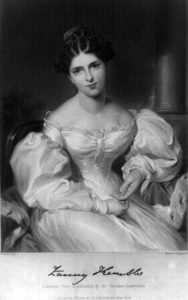
Frances Kemble
*Frances “Fanny” Kemble was born on this date in 1809. She was a white-British actress, author, and abolitionist.
Frances Anne Kemble was a member of the famous Kemble theatrical family. She was the oldest daughter of actor Charles Kemble and his actress wife Maria Theresa De Camp and the niece of noted tragedienne Sarah Siddons. Fanny was born in London and educated chiefly in France.
Fanny Kemble first appeared on the stage as Juliet at Covent Garden on October 26, 1829. In 1832, she accompanied her father on a theatrical tour of the U.S. Kemble and the company toured the United States for two seasons, playing to wildly enthusiastic audiences. Kemble published a record of her two-year theatrical tour, “Journal of a Residence in America” (1835). It was an intelligent and genuinely good-humored account, but such publications by foreigners were the rage then, and thin-skinned critics made her the target of journalistic wrath.
That same year, she met one of her most ardent admirers, Pierce Butler, the American heir of one of the largest slaveholders in Georgia. His grandfather was Major Pierce Butler, a Revolutionary War veteran, a U.S. senator from South Carolina, and a founding father who wrote the Constitution's Fugitive Slave Clause. Major Butler owned 638 slaves and was one of the wealthiest men in the United States. He also owned a mansion in Philadelphia and a country home near the city. His grandson was the heir to all this wealth.
Kemble was happy to retire in 1834 to become the wife of Butler. Despite her success, she hated what she thought of as the artificiality of acting. When the couple married, he was not a slaveholder, but Pierce Butler had inherited his grandfather's property by the time their two daughters, Sarah and Frances, were born. In March of 1836, Pierce and his brother John inherited two sea-island plantations, one on St. Simon's Island, where sea-island cotton was grown, and one on Butler Island, where rice was grown,
Kemble wanted to see the plantation firsthand and begged Butler to take her with him. He refused on his first trip, but in December of 1838, Pierce, Fanny, their two children, Sarah and Frances, and their Irish nurse, Margery O'Brien, set out for Butler Island. Nothing in Kemble’s life had prepared her for this place. Fanny was shocked by the conditions of slaves and their treatment. She tried to better their conditions and complained to her husband about slavery.
The marriage was troubled nearly from the start. Fanny believed that Pierce would continue in his devotion, and Pierce believed that Fanny would curb her independent nature and allow him to rule over her. Their differences over slavery added to the friction. When she left his plantations in the spring of 1839, debates about slavery and marital tensions continued.
Unable to live with slavery, she withdrew, first visiting England in 1841 and breaking formally with her husband in 1846. The couple was divorced in 1849, with Pierce keeping custody of the two daughters until they came of age. For a year, she returned to the British stage and, in 1847, moved to Italy, where she wrote: “A Year of Consolation” (1848). Kemble returned to the United States, making a career of giving public readings of Shakespeare. This innovation brought her enthusiastic applause and a more than decent income.
She was reunited with each of her girls when they turned 21. Kemble recorded her experiences in letters, which she later compiled and published. Kemble and her daughter Sarah were pro-North in the American Civil War; Butler and their daughter Frances were pro-South. In early 1861, Butler and their daughter Frances went to Georgia.
Upon their return to Philadelphia in August, he was arrested for treason and released in September. In 1863, in a successful attempt to influence British public opinion against the Confederate states, Kemble published an account of her plantation experience, “Journal of a Residence on a Georgia Plantation.” It is the closest, most detailed look at plantation slavery ever recorded by a white northern abolitionist.
Following the war, Butler returned to Butler Island with his daughter, Frances. He found several former slaves living there and arranged for them to work for him as sharecroppers. Management of the plantation was complex, and though Frances returned to Philadelphia, Pierce remained on the island despite the dangers of the disease. He contracted malaria and died in August 1867.
Following Pierce's death, Kemble returned to Butler Island to continue organizing the plantation and then moved to Philadelphia. Throughout her life, Kemble performed dramatic readings, traveled, and published her journals. She later published volumes of an autobiography, literary criticism, and a novel, “Far Away and Long Ago” (1889). Fanny Kemble died peacefully in London on January 15, 1893.